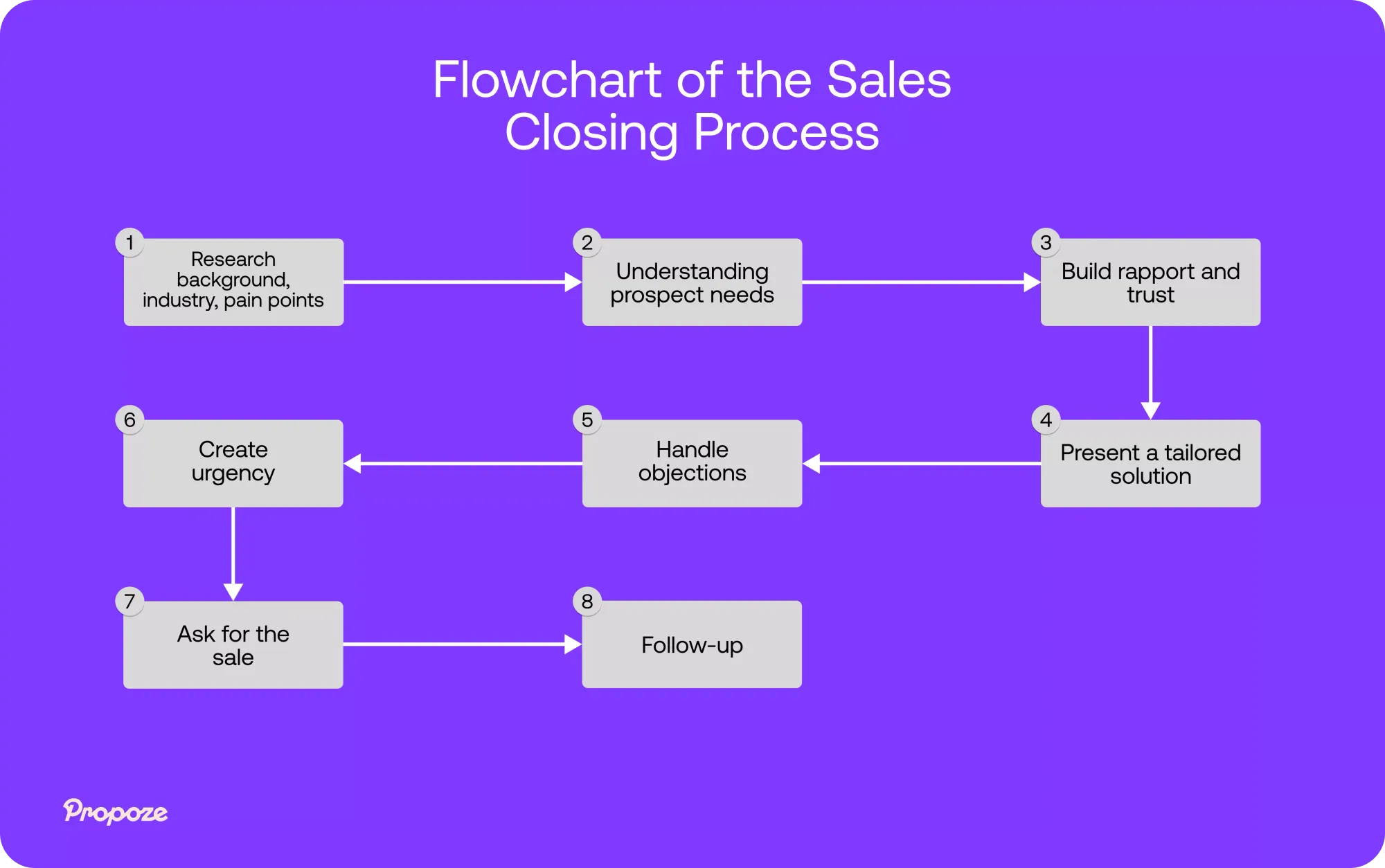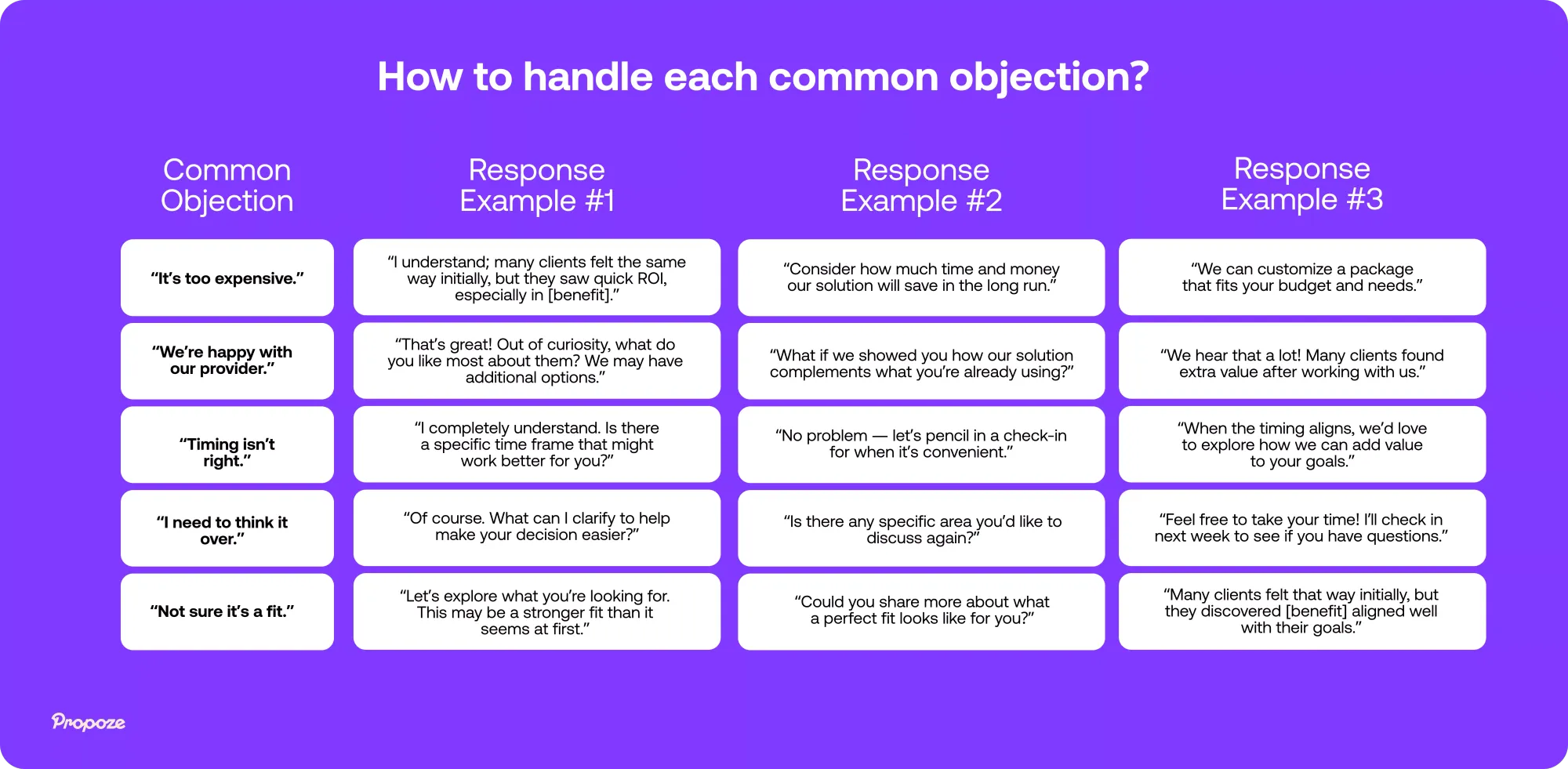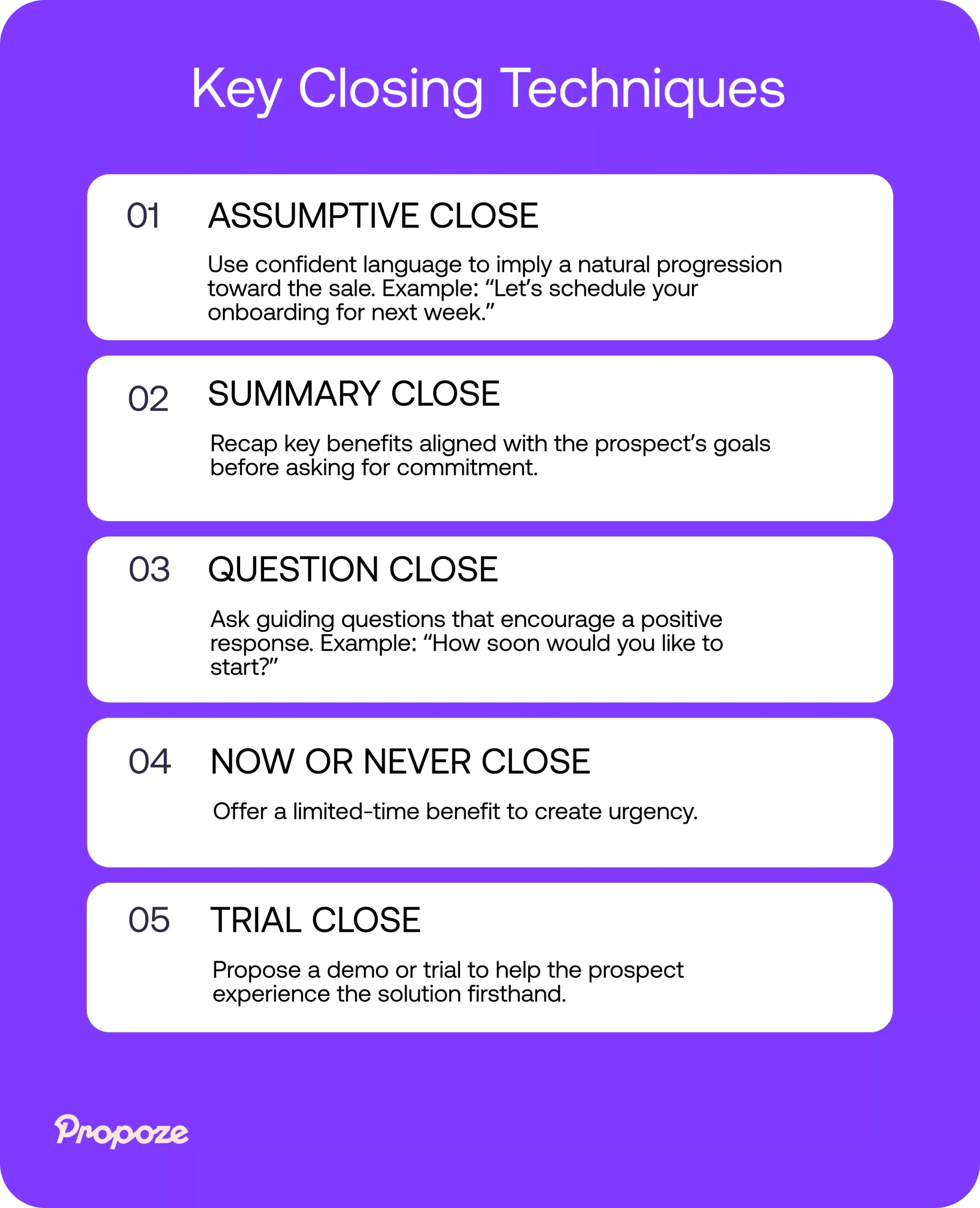How to Close a Sale: The Ultimate Guide
Get ready to close the sale like a pro, every time.
— Propoze

Closing a sale can feel like the toughest part of the sales process, but it’s really just a natural step when you’re in tune with your prospect.
Imagine this guide as your go-to resource for all things closing — whether it’s handling objections, reading buying signals, knowing when and how to ask for the sale, or implementing effective closing strategies tailored to individual prospects.
We’ll cover expert techniques that make closing feel less like a pitch and more like a conversation that leaves both sides ready to say, “Yes!”
Understanding the Sales Process
Understanding the sales process is crucial for closing deals effectively.
The sales process typically involves several stages, including prospecting, qualifying, needs analysis, presentation, handling objections, and closing.
Each stage requires a different set of skills and strategies to move the prospect closer to making a purchase decision.
By understanding the sales process, sales teams can better navigate the complexities of the sales cycle and increase their chances of closing deals.
Effective sales teams recognize that the sales process is not a linear progression, but rather a dynamic and iterative process that requires flexibility and adaptability.
They understand that each prospect is unique and may require a customized approach to meet their specific needs and pain points.
By taking the time to understand the sales process and the needs of their prospects, sales teams can develop effective sales strategies that drive results.
What does closing a sale mean?
Closing a sale is the moment where exploration becomes commitment.
It’s all about guiding a potential client from interest to decision, securing their “yes” not just to make the sale but to build a partnership that feels mutually beneficial.
Closing means aligning on specifics like product fit, terms, and timing while instilling confidence that your solution is the right choice.
For the client, a strong close assures them they’re investing in something valuable.
For you, it’s the confirmation of a job well done and the foundation of a trusted relationship.
Whether it’s a signed contract or verbal commitment, a successful close is a key milestone — one that transforms a prospect into a valued customer and sets the stage for future success by effectively closing the sales deal.
Why closing techniques matter
Closing techniques are a bridge that turns interest into commitment and builds genuine connections.
Effective closing techniques directly impact conversion rates by making it easier for clients to make decisions. When used well, they reduce hesitation, creating a smooth path toward a “yes.”
They also build trust — clients feel guided rather than pressured, which builds confidence in your offer and fosters long-term relationships.
Over time, strong closing techniques drive business growth by establishing a reputation for care, consistency, and professionalism, helping you gain more referrals and repeat clients.
By using the right closing technique, sales teams can increase conversions, build client trust, and lay the foundation for a positive business relationship.

Step-by-step guide to closing a sale in the sales process
Closing a sale successfully is about taking thoughtful, intentional steps from your first contact with a prospect to the final follow-up.
Here’s a guide to ensure every stage strengthens your chance of closing:
Step 1: Understanding your prospect’s needs
Closing a sale starts with understanding what truly matters to your prospect.
Before your meeting, do some background research on their company, industry, and recent updates, so you have a clear idea of potential challenges.
2️⃣ Listen carefully for recurring pain points or specific goals.
3️⃣ Connect your solution directly to what they’ve shared. Show exactly how your product can make their goals achievable.
This approach shows genuine interest and helps the prospect feel understood and valued, naturally leading toward a close.
Step 2: Build rapport and trust
Trust is at the heart of every strong sales relationship.
Here’s how to build it:
2️⃣ Acknowledge their struggles. Simple statements like “I can see why that’s frustrating” help prospects feel understood. Empathy shows that you’re invested in solving their problems, not just making a sale.
3️⃣ Offer genuine solutions. Ask thoughtful questions like, “Have you tried [specific strategy]?” or “Would it help if…” Providing advice based on their needs positions you as a trusted advisor, not just a salesperson.
4️⃣ Briefly mention past clients with similar challenges and how your solution helped them. Real-life examples make your offer relatable and build credibility.
5️⃣ After a meeting, send a recap email highlighting key points they shared and offering further resources if needed. This reinforces that you’re committed to their success beyond the initial conversation.
Each technique shows prospects that you’re genuinely there to help, establishing a strong foundation of trust and making the path to a close more natural.
Step 3: Present a tailored solution
When presenting a solution, it’s essential to make it feel like it was designed specifically for your prospect.
Go beyond standard features by showing how they align with their exact goals and industry-specific needs:
2️⃣ Tie in specific numbers to illustrate the impact—“Our tool has helped reduce downtime by 30% for similar clients.”
3️⃣ Share brief success stories of clients in their industry. “One of our retail clients cut inventory management time by half.”
This approach not only strengthens engagement but also builds confidence in your solution’s ability to deliver real results.
Step 4: Handle objections with confidence
Handling objections is an opportunity to strengthen your proposal and show the prospect that you’re responsive to their concerns.
Here are some strategies:
2️⃣ Reframe objections as opportunities. If they’re concerned about price, explain the ROI and long-term savings they can expect. For timing, discuss how your solution can make their current process easier or faster.
3️⃣ Share testimonials, case studies, or metrics that address similar concerns from past clients. Data-driven responses reinforce trust.
4️⃣ If an objection is vague, ask for specifics. “Could you elaborate on what you need from a solution like ours?” Clarifying helps you address their true pain points directly.
When you handle objections confidently and turn concerns into discussion points, you position yourself as a trusted advisor, not just a salesperson.

Step 5: Create urgency without pressure
Creating urgency shouldn’t feel forced — it should be a well-crafted sales tactic that helps prospects see the immediate value of taking action.
Here’s how to do it in a way that respects their decision-making process:
2️⃣ Highlight benefits they can see right away. For example, “By starting now, you’ll see faster results on [specific challenge],” emphasizes value without rushing them.
3️⃣ If demand is high or scheduling is tight, let them know honestly. For instance, “We have limited slots available this quarter, but I’d love to secure yours if it feels right,” adds a genuine sense of scarcity.
Creating urgency this way makes the prospect feel in control and aware of the real opportunities they could miss without making them feel pushed.
This approach builds trust and increases the likelihood of a confident “yes.”
Step 6: Ask for the sale directly
Asking for the sale directly is a pivotal step, showing confidence and clarity that prospects appreciate.
After you’ve built rapport, demonstrated value, and addressed their concerns, it’s time to make a clear ask.
The key here is timing: look for signals that show they’re ready to move forward, such as enthusiastic questions, detailed inquiries about next steps, or positive body language if in person.
When the moment feels right, use straightforward, positive language.
1️⃣ “Shall we get started?” emphasizes moving forward.
2️⃣ “Are you ready to make this work for you?” invites them into the process with confidence.
3️⃣ “Can we finalize the details and get you onboarded?” shows you’re prepared to take action.
Confidence is contagious.
When you’re clear in asking for the sale, you help the prospect feel confident in saying “yes,” reinforcing that they’re making the right choice.
Step 7: Follow up effectively
When a prospect needs more time, following up is about staying helpful and relevant without coming across as pushy.
Here’s how to keep the conversation open and reinforce value:
2️⃣ Add new value: Share something genuinely useful, like a case study or industry report, related to their goals. For example, “I thought you’d find this study on increasing conversion rates helpful, as it speaks to our conversation about growth.” This gesture shows you’re invested in their success, not just the sale.
3️⃣ Respect their timeline: If they’ve mentioned needing time, ask when they’d like to reconnect or set a reminder to check back in a few weeks. Phrasing like, “I’m here whenever you’re ready to continue the conversation,” keeps things open while giving them space.
4️⃣ Stay top-of-mind with light touches: A brief, friendly check-in like, “Just checking in — let me know if any questions have come up,” can be a helpful nudge that feels natural.
By following up thoughtfully and respecting their timeline, you maintain the relationship and make it easy for them to return to you when they’re ready.
6 must-know effective sales closing techniques
Closing a sale can feel like an art, especially when every client is different.
Having a variety of closing techniques helps you adapt to each conversation naturally, making the close feel effortless and authentic. Some clients respond best to confident, assumptive closes, while others need a softer approach, like a trial close.
In the following sections, we’ll explore some of the most effective closing techniques.

Technique 1: Assumptive close
The assumptive close is a confident, natural way to guide prospects toward a “yes” by helping them imagine themselves as clients. This technique involves using language that implies they’re ready to move forward, subtly encouraging commitment.
Instead of asking, “Would you like to sign up?” try saying, “I’ll go ahead and reserve a slot for onboarding next Tuesday. How does that sound?”
1️⃣ Use familiar language: Keep your tone friendly and conversational—this keeps the ask light and natural.
2️⃣ Adapt to context: In email, use assumptive language like, “I’ll prepare the paperwork for your review by end of day,” to keep momentum without overwhelming.
3️⃣ Balance confidence and flexibility: Be prepared for hesitation and have a plan to guide the conversation back to their needs.
The assumptive close helps clients feel comfortable moving forward, as it reinforces their interest and keeps the process easy and pressure-free.
Technique 2: Summary close
The summary close is all about reinforcing the value of your solution by highlighting the key benefits right before asking for commitment. It’s especially useful when a prospect may need reassurance that your solution directly addresses their needs.
1️⃣ Zero in on what matters most: Recap the benefits that align most closely with their goals. For instance, “This solution will save you X hours each week, reduce costs by Y%, and free up time for strategic projects.”
2️⃣ Keep it conversational: Use clear, positive language that feels natural and easy to agree with. After summarizing, follow with a confident, open-ended question like, “Does this sound like it checks all the boxes for you?”
3️⃣ Handle hesitation smoothly: If they seem uncertain, ask if there’s anything they’d like clarified, showing openness to further discussion.
A summary close provides a clear path forward by giving the prospect one final look at how your solution fits perfectly with their needs.
Undoubtedly, it makes it easier for them to say “Yes.”
Technique 3: Now or never close
The “Now or Never” close is about creating urgency that encourages your prospect to make a decision. By offering a limited-time discount, bonus, or priority spot, you frame the decision as a valuable opportunity they won’t want to miss.
Try saying, “This rate is available until Friday, so let’s lock it in while it lasts.”
1️⃣ Present genuine opportunities: Only offer limited-time deals when they’re truly time-sensitive. Prospects can spot insincerity, so make it count.
2️⃣ Highlight immediate value: Explain what they gain by acting now — be it savings, added benefits, or priority access. Example: “By signing on now, you’ll secure this rate and avoid next month’s price increase.”
3️⃣ Keep it friendly: Use an inviting tone, making it clear this offer benefits them without feeling like high-pressure sales.
When used authentically, the “Now or Never” close helps prospects feel they’re getting a valuable advantage, giving them the confidence to say “yes” with no regrets.
Technique 4: Takeaway close
The takeaway close is a technique that leverages scarcity to spark interest.
By subtly suggesting that your product may not be available — or may not be ideal for everyone — you tap into a prospect’s fear of missing out, encouraging them to consider it more seriously.
For example, you might say, “This solution typically fits clients who are ready to take immediate action. Do you think that’s where you are?”
1️⃣ Position as selective: Frame it as a tailored fit. “Most of our clients who commit at this stage get the full value.”
2️⃣ Let them reconsider: Often, gently pulling back makes prospects reassess their interest, especially if they’re on the fence.
The takeaway close is a subtle nudge, not a push. It helps prospects realize that choosing your solution is an exclusive opportunity they don’t want to miss.
Technique 5: Question close
The question close is all about gently guiding prospects toward a “yes” by helping them visualize the benefits of your offer.
By asking targeted questions, you let them reflect on how well your solution fits, creating a feeling of natural alignment without any pressure.
1️⃣ “How do you see this fitting in with your current goals?” — helps them confirm that the solution aligns with their needs.“
2️⃣ What would be the ideal timeline for seeing these results?” — makes them consider the immediate benefits of moving forward.“
3️⃣ Is there anything else you’d like to discuss before we start?” — encourages them to voice any last-minute questions, creating a smoother close.
The question close works by inviting the prospect to affirm their decision, making the final “yes” feel like a choice they’re fully invested in.
Technique 6: Trial close
The puppy dog close lets prospects experience your product firsthand, reducing the perceived risk of commitment.
By offering a trial or demo, they get a hands-on look at the benefits, making it easier to envision how your solution fits their needs.
1️⃣ Highlight benefits: Frame the trial as an opportunity to see results — “This demo will show you exactly how much time you could save.”
2️⃣ Encourage exploration: Invite them to ask questions and experiment with the product during the trial to maximize their experience.
Advanced closing tips
Mastering the right sales closing technique can make all the difference in sales.
Going beyond basic approaches, these tips help you fine-tune your approach, adapt to each client’s unique needs, and handle complex situations with confidence.
From understanding buyer psychology to using strategic pauses, advanced tactics allow you to be flexible, intuitive, and responsive to signals during the conversation.
In the following sections, we’ll dive into pro tips that cover everything from overcoming last-minute objections to using social proof effective.

Tip 1: Leverage social proof
Social proof helps prospects feel confident by showing that others have achieved results with your solution. The key is to share stories that feel relatable and credible, adding trust to your offer.
1️⃣ Relevant testimonials: Use testimonials from clients in the same industry or facing similar challenges. For instance, “A client in [industry] saw a 30% efficiency boost using our solution!”
2️⃣ Case studies with impact: Present case studies highlighting measurable results, like revenue growth or time savings.
3️⃣ Encourage peer referrals: Offer prospects the chance to speak with satisfied clients or share referral stories to build trust.
When you frame social proof around results and experiences that resonate with your prospects, you make it easier for them to visualize their own success with your product.
Tip 2: Addressing opportunity cost
Opportunity cost is a powerful concept to help prospects see what they’re missing by not choosing your solution. Instead of focusing solely on benefits, emphasize what they stand to lose if they delay or opt out.
1️⃣ Highlight immediate gains: Show how acting now can save them time or money. For example, “By starting this month, you could see a 15% boost in efficiency within the quarter.”
2️⃣ Illustrate long-term losses: Point out missed growth potential or reduced competitiveness—“Other clients in your industry are already seeing faster results; let’s not let this gap grow.”
Framing your solution around opportunity cost helps prospects recognize the unique value they’ll gain by taking action now.
Tip 3: Personalizing the close
Tailoring your closing approach shows prospects that you genuinely understand their unique situation.
1️⃣ Industry needs: Connect benefits to their specific industry challenges. For example, if they’re in healthcare, emphasize security features.
2️⃣ Client personality: If they’re detail-oriented, focus on specifics; if they’re big-picture thinkers, highlight overarching benefits.
3️⃣ Relationship stage: New contacts need trust-building; long-term prospects may want clear next steps for partnership.
Personalizing your close strengthens the connection, making the decision feel more natural.

Best practices for closing sales deals
Closing sales deals requires a combination of skills, strategies, and best practices. Here are some best practices for closing sales deals:
- Know your product or service: Understand the features, benefits, and value proposition of your product or service inside and out.
- Understand your prospect’s needs: Take the time to understand your prospect’s pain points, goals, and objectives.
- Develop a strong relationship: Build trust and rapport with your prospect to increase the chances of closing the deal.
- Use effective sales closing techniques: Use a range of sales closing techniques, such as the summary close, question close, and assumptive close, to move the prospect closer to making a purchase decision.
- Handle objections effectively: Anticipate and address objections in a clear and concise manner to overcome any concerns the prospect may have.
- Create a sense of urgency: Use scarcity, limited-time offers, or other tactics to create a sense of urgency and encourage the prospect to make a decision.
- Follow up: Follow up with the prospect after the initial meeting to answer any additional questions and provide further information.
By following these best practices, sales teams can increase their chances of closing sales deals and driving revenue growth.
Industry-specific closing approaches
Customizing your sales tactics to fit the unique challenges and priorities of each industry can make your approach feel more relevant and build stronger connections.
Here’s how to refine your closing tactics across different sectors:
1. SaaS (Software as a Service)
SaaS buyers look for immediate ROI and scalability, so offering a hands-on experience with the product can make all the difference.
- Highlight immediate value: Offer a quick demo or trial, showcasing instant benefits like streamlined workflows or cost savings. Clients often want proof that the software will have a quick impact.
- Focus on metrics and ROI: SaaS buyers appreciate numbers. Use data, such as “Our tool has reduced onboarding time by 30% for similar companies,” to illustrate potential impact.
- Emphasize scalability: Assure clients that the software can grow with them. Discuss flexible subscription models or upcoming features that align with their future goals.
2. Finance
In finance, trust and precision are essential. Financial clients need assurance that your solution is reliable and meets industry standards.
- Build trust through proven results: Share testimonials or case studies from recognized financial institutions to showcase reliability.
- Highlight compliance and security: Emphasize regulatory compliance (e.g., SOC 2, GDPR) and secure data handling, addressing concerns around sensitive information.
- Use a data-driven pitch: Finance professionals respond to numbers and specifics. Present clear ROI metrics and results that show how your product impacts their efficiency and reduces risks.
3. Real Estate
In real estate, timing and emotional appeal play significant roles. Buyers are often driven by urgency, investment potential, or personal connection to a property.
- Create timely urgency: Real estate clients value immediacy. Use language like, “Properties in this area are moving quickly,” to emphasize the need for prompt decisions.
- Appeal to lifestyle or investment value: Describe the lifestyle benefits of a residential property or the ROI of a commercial space, making the offer feel relatable and desirable.
- Showcase market expertise: Provide insights into local market trends or recent sales in the area. A client will feel more confident if they see you as a knowledgeable insider.
4. Healthcare
Healthcare buyers prioritize compliance, accuracy, and efficiency. Your solution needs to demonstrate alignment with these values.
- Focus on regulatory compliance: Highlight how your product meets healthcare regulations like HIPAA, ensuring data protection and adherence to industry standards.
- Emphasize patient-centered outcomes: Illustrate real-life impacts, such as reducing administrative tasks or improving patient care quality. For example, mention how similar healthcare providers have used the tool to streamline operations.
- Demonstrate time and cost savings: Healthcare professionals are often pressed for time. Emphasize how your solution frees up time, allowing staff to focus more on patient care.
5. Retail
Retailers are focused on customer experience, cost efficiency, and adapting to peak sales periods. Your pitch should touch on these elements.
- Enhance the customer experience: Highlight how your solution can lead to better customer engagement, quicker transactions, or a smoother online shopping experience.
- Focus on cost-efficiency: Retailers are often budget-conscious. Describe how your solution optimizes operations, like inventory management or logistics, to improve their bottom line.
- Adapt to seasonality: Retail is highly seasonal. Mention how your solution can support them during peak periods like holidays or major sales events, ensuring they’re prepared for demand spikes.
Each of these industry-specific approaches helps you connect more deeply with your prospect, positioning your solution as the most relevant choice to meet their unique needs and priorities.

What to do after closing a sale
After closing a sale, it’s essential to ensure that the customer is satisfied with their purchase and to provide ongoing support to build a long-term relationship. Here are some steps to take after closing a sale:
- Provide excellent customer service: Ensure that the customer receives excellent customer service and support to build trust and loyalty.
- Follow up: Follow up with the customer to ensure that they are satisfied with their purchase and to address any concerns they may have.
- Offer additional products or services: Offer additional products or services that may be of interest to the customer to increase revenue and build a long-term relationship.
- Request feedback: Request feedback from the customer to understand their needs and preferences and to identify areas for improvement.
- Use the sale as a reference: Use the sale as a reference to build credibility and trust with future prospects.
By taking these steps, sales teams can build long-term relationships with their customers and increase the chances of repeat business and referrals.
Final steps to close more sales and build client trust
Customer satisfaction isn’t just about the “yes” — it’s about building connections that last.
Take time to understand each client’s unique needs, handle objections with care, and focus on constant improvement.
Each sale is a chance to learn and grow, both in skill and relationships.
Ready to put these strategies into action?
Test them out in your next sales call, and don’t hesitate to adjust based on what feels right for each client.
Tools like Propoze can make follow-ups smoother, keep track of performance, and streamline your closing process. Create your account and start with our free trial today!
Frequently asked questions about closing sales
Let’s dive into some frequently asked questions about closing sales, with simple answers to help you close more confidently.
What does "closing the deal" mean?
Closing the deal is the final step in a sales conversation, where the client agrees to move forward with the purchase. It’s about securing commitment and often involves an official agreement or verbal confirmation.
Think of it as establishing trust and setting the stage for a lasting relationship.
How should I handle common objections in sales?
When objections come up, see them as opportunities rather than roadblocks.
Start by acknowledging the concern, showing empathy, and providing relevant insights. If they’re worried about budget, explain how the investment can pay off in the long run. A respectful and understanding approach can turn objections into deeper discussions and help build trust.
How can I create urgency without pressure?
Creating urgency is about helping prospects see the benefit of acting now.
You might mention a limited-time offer or a special incentive — phrases like, “This rate is available until the end of the month,” can encourage timely action without pressure.
Also, emphasizing immediate advantages, such as faster results, can make it feel natural to start soon.
What’s a good approach for indecisive prospects?
For clients on the fence, a trial close can help gauge their interest: “Do you feel this aligns with your goals?”
If they’re hesitant, recap the main benefits they’ve shown interest in and invite questions. Sometimes giving them a chance to express concerns openly gives them the confidence to commit.